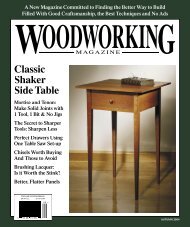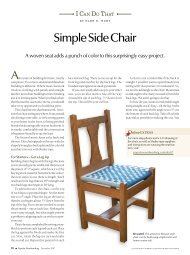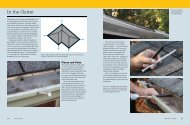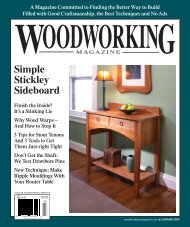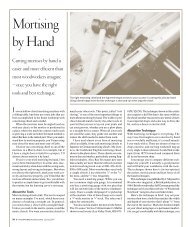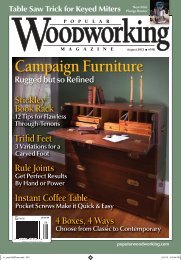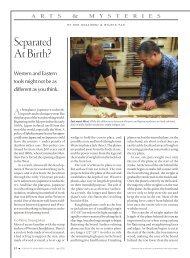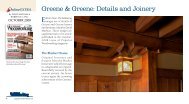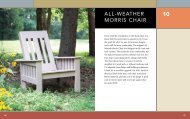Spring 2008 - Popular Woodworking Magazine
Spring 2008 - Popular Woodworking Magazine
Spring 2008 - Popular Woodworking Magazine
Create successful ePaper yourself
Turn your PDF publications into a flip-book with our unique Google optimized e-Paper software.
Understanding Western BacksawsThe Western backsaw hasalmost vanished. But a fewtoolmakers are trying to turnback the clock to when thissaw was in every toolbox.The backsaws that built nearly every piece ofantique English and American furniture almostbecame extinct, thanks to the universal motor andthe Japanese obsession with quality.A basic kit of at least three backsaws – a dovetail,carcase and tenon saw – were in the toolboxof every English-speaking cabinetmaker andjoiner in the 18th, 19th and early 20th centuries.But after World War II, the manufacturingof these venerable saws went into steep declinewith the rise of inexpensive portable routers andsaws that were powered by the compact and cheapuniversal motor.Handsaw giants such as Disston and Atkinsfaltered. Their enormous factories were shuttered,and the remnants of these companies beganchurning out low-quality saws with chunky handlesand poorly formed teeth.But it wasn’t portable power tools that deliveredthe coup de grace to Western handsaws. Thatoccurred at the hands of Japanese sawmakers.As Western saws became worse, the high-qualityJapanese saw became more attractive to thewoodworker who still needed a backsaw or twofor joinery.Thanks to Japan’s thriving carpentry tradethat still requires handwork (a result of their traditionaltimber-frame construction), outstandingmanufacturing acumen and a general respect fortraditional ways, Japanese saws were inexpensiveand worked extremely well.This was the opposite of the pricey and snaggle-toothedWestern saw, which barely cut wood.And so the Japanese saw – which was once thelaughingstock in the West as the tool that cutbackward – became the best-selling style of sawin North America in less than a generation. Andit is, by far, the dominant form today.Western backsaws come in a dizzying array of sizes and tooth configurations. Add to that some confusingnomenclature (sash saw? carcase saw?) and it’s no wonder people are confused. We help you choosethe three backsaws you need for hand-cut joinery.Two Guys Revive a Dead PatientAnd if it weren’t for two tool collectors, that mighthave been the final word: Either buy antique Westernsaws or new Japanese ones. But thanks to PeteTaran and Patrick Leach, the Western saw is todayexperiencing a revival. The two men had technicalbackgrounds in engineering and software, butthat didn’t stop them from becoming sawmakersin 1996. They founded Independence Tool andstarted making a maple-handled dovetail sawbased on an early 19th-century example.The saw, which was made with an incredibleamount of handwork, became a cult classic amongwoodworkers on the Internet, and the saw beganappearing in tool catalogs alongside the pagesand pages of Japanese saws.The Independence saw itself was a technicalsuccess. I’ve inspected and used pristine examplesof these saws and I can personally attest that theywere a revelation when compared to the chunky,lifeless and dull Western backsaws I used in myfirst woodworking class.But the company was short-lived. Leach leftIndependence Tool and went on to become afull-time tool dealer (his site is supertool.com),and Taran announced in 1998 that he wasn’t ableto do his day job and still make saws at night. Itlooked like quality Western backsaws were aboutto disappear off the market again.But then Taran sold Independence Tool toLie-Nielsen Toolworks, which was crankingup its production of handplanes but wasn’t yetmaking saws. (Taran isn’t entirely out of the sawbusiness. He now sells restored antique saws atvintagesaws.com as a side job.) Shortly after thesale, Lie-Nielsen began offering a dovetail saw– branded with both the Independence and Lie-Nielsen names – and then the company beganselling other patterns of Western saws.Recently, others makers have entered theWestern saw market, including Adria Tools,Wenzloff & Sons, Gramercy Tools and a hostof other small makers. And while these companiesare making just a dent in the market sharecommanded by the Japanese sawmakers, it isnow possible to purchase an entire kit of qualityWestern backsaws that work right out of the box.And that is a milestone.20 ■ woodworking magazine <strong>Spring</strong> <strong>2008</strong>
One of the earliest tool catalogs we have, “Smith’s Key,” shows the four typesof backsaws available in 1816 from makers in Sheffield, England. Note howthis tool catalog shows the blades as tapered – they are narrower at the toethan at the heel. There’s a likely reason for that.The saw on the bottom is a typical pistol-grip dovetail saw from sawmakerMike Wenzloff of Wenzloff & Sons. Also shown (at top) is a straight-handleddovetail saw known as a gent’s saw, so named (we’re told) because it wasused by gentlemen hobbyist woodworkers in the 19th century.Why Use Western Handsaws?If you do the math, mass-produced high-qualityJapanese saws are a bargain. You can buy aJapanese dovetail saw for $35 that works just aswell as a $125 Western-style dovetail saw. Plus,the consensus among many craftsmen and woodworkingmagazines is that the Japanese saws areeasier to start and cut smoother.So why would anyone (with the exception of ahistorical re-enactor or pigheaded purist) buy anexpensive Western saw? The differences betweenthe two tools are more extensive than the fact thatone cuts on the pull stroke and the other cuts onthe push. The sawplate on Japanese saws is thinner.Japanese teeth are more complex and longer.And sharpening Japanese teeth yourself can bedifficult or impossible, depending on the saw.As a result of these differences, Japanesesaws are easier to kink and ruin, especially inunskilled hands. The teeth can break off in somehard Western-hemisphere woods – I’ve had particularproblems in ring-porous species such aswhite oak. The expensive Japanese saws need tobe sent to a specialist for resharpening (sometimesthis specialist is in Japan). The inexpensive sawshave impulse-hardened teeth, which makes themlast a long time but also makes them impossibleto refile. The teeth are as hard as a file, so a sawsharpeningfile cannot abrade them. This makesthe saws somewhat disposable – though you cancut up the sawplates, discard the super-hard teethand make some thin scrapers with the steel.In contrast to Japanese saws, Western sawshave robust teeth. When I tally the tooth-decayproblems I’ve had with saws, I’ve probably lost 20teeth in Japanese saws but have yet to chip a toothon a Western saw. You can resharpen Westernteeth yourself, or get the job done domestically.Any Western saw can last for generations.For some woodworkers, the above reasonsare a compelling reason to use Western saws.If you are one of those, read on. If you still preferJapanese saws and want to learn more aboutusing them for joinery, I recommend you getyour hands on the immensely readable “JapaneseTools: Their Tradition, Spirit and Use” (Linden)by Toshio Odate.Four Western BacksawsThe backsaws shown in this article are particularto the English-speaking world for the mostpart. Traditional European woodworkers still useframe saws, where a thin sawblade is held in tensionin a wooden frame, though other saw formsare available and used on the Continent.Western backsaws are typically separatedinto four forms, and their details (blade length,number of teeth etc.) are usually traced backto Edward H. Knight’s 1876 opus “AmericanMechanical Dictionary.” But some modern woodworkersare confused about which of these foursaws they need in their shop, so here is a discussionof each saw, its details and the operationsthat it excels at.The Dovetail SawThe most familiar saw to modern eyes, the dovetailsaw is the smallest backsaw and has a bladethat is 6" to 10" long. The blade’s width is between1 1 ⁄ 2" and 2". It can have a pistol-grip or a straighthandle. Most beginners seem to prefer the pistolgrip because it whispers to your body when the“If not for the sea,we’ d have to carry our boats”.— Norwegian sayingblade is straight up and down. However, usinga straight-handled “gent’s saw” isn’t difficult. Itjust takes a little more getting used to.The teeth of a dovetail saw are quite fine,between 14 and 18 points per inch (ppi) is typical.However I’ve seen dovetail saws with as manyas 23 ppi.Most woodworkers prefer the teeth filed for arip cut – a rip tooth has its cutting face filed so itis 90° (or nearly so) to the sides of the tooth.Recently, Lie-Nielsen Toolworks has begunmaking a dovetail saw with what is called “progressivepitch.” At its toe, the saw has 16 ppi.Each tooth gets bigger and bigger until the sawhas 9 ppi at the heel. The fine teeth make thetool easy to start and the coarse teeth at the heelmake it cut fast. The resulting finish is remarkablysmooth and after using this saw for a coupleyears, I have become quite fond of it.The number of teeth on your dovetail sawshould relate to what kind of job you use that sawfor. When you have fewer teeth, the saw will cutfaster but coarser. The speed comes from the factthat fewer teeth equals deeper “gullets,” which isthe space between each tooth. When gullets fill upwith waste, the saw stops cutting until the sawdustis removed as the tooth exits the work.So a fine-tooth saw works well for small workin thin material, such as 1 ⁄ 2"-thick drawer sides.A coarse dovetail saw works better when sawingcarcase dovetails in 3 ⁄ 4" stock or thicker. Youdon’t have to have two dovetail saws, however.I’d just pick a saw that reflects the work you domost of the time.Speaking of pushing your tool into unfamiliarterritory, many woodworkers end up using theirdovetail saw for other chores, including somecrosscutting. You can get away with this manytimes because the teeth of the saw are so fine.woodworking-magazine.com ■ 21
A classic vintage carcase saw from Wheeler, Madden & Clemson. This saw is14" long and has 12 ppi. The carcase saw is used for almost all joinery crosscutswhen building furniture.These two saws are so different in size that it’s hard to believe that they bothare called tenon saws. The big saw is a much older (and almost extinct) form.However, your cut will be more ragged than ifyou used the correct tool: the carcase saw.The Carcase SawBy far, the most-used saw in my shop is my carcasesaw. This saw is so named because it is usefulfor many operations in building a furniturecarcase. A Western carcase saw always has apistol grip, though ancient versions might havelooked more like a chef’s knife with a straighthandle and no back.The blade of a carcase saw is 10" to 14" longand 2" to 3" wide. It typically has 12 to 14 ppi, andthe saw teeth are sharpened to make crosscuts.A crosscut tooth looks different than a rip toothin that its cutting surface is at a 15° to 24° angleto the sides – 20° is typical. This angle is called“fleam” and it allows the tooth to sever the grainlike a knife, reducing the raggedness that wouldbe left behind by a rip tooth.I haven’t found the number of teeth in a carcasesaw to be as critical as it is with the other formsSuppliesAdria <strong>Woodworking</strong> Tools604-710-5748 or adriatools.comGramercy ToolsFrom Tools for Working Wood800-426-4613 ortoolsforworkingwood.comLie-Nielsen Toolworks800-327-2520 or lie-nielsen.comWenzloff & Sons Saw Makers503-359-4191 or wenzloffandsons.comof saws. A 12-point saw and a 14-point saw cutplenty fast enough for most operations, and theyboth leave an acceptable surface behind.The difference I think you should pay attentionto is the length of the blade. In general, longersaws tend to saw straighter, so I avoid saws thatare 10" long. Getting an 11" saw makes a difference.A 14"-long saw even more so.Keep in mind that a saw doesn’t have to belabeled a carcase saw to be a carcase saw. Thereis some overlap in the saw forms. Pay attentionto the specs of a saw in a catalog or in the store.A saw that is 14" long and filed crosscut with 12-14 ppi is a carcase saw, no matter what the toolseller might label it.Carcase saws are the jack plane of the backsawfamily. They get used for everything, from cuttingtenon shoulders to trimming through-tenons tonotching out corners to cutting miters. I use themfor cutting door rails and stiles to length whenworking by hand – pretty much any precisioncrosscut that is on a board that is less than 6" wide.Plus, almost every time I reach for my carcasesaw I’m also reaching for my bench hook.Tenon SawsWhen you start wading into tenon saws, it canget confusing. Knight’s dictionary says a tenonsaw should be 16" to 20" long (that’s huge) and3 1 ⁄ 2" to 4 1 ⁄ 2" wide (also huge). Tenon saws shouldhave about 10 ppi.Modern tenon saws are not nearly this big.These ancient giant tenon saws have nearlydisappeared, except in vintage tool collectionsand from one lone maker, Wenzloff & Sons. Ipurchased one of these old-school tenon sawsand was surprised (strike that, amazed) at howeasy it is to use, even when cutting tenons thatwere dwarfed by the saw’s blade.The long blade definitely helps the saw tracka line straighter and work quickly – a 1 1 ⁄ 4" tenoncheek can be sawn down one side in six to sevenlong strokes. And the extra weight of the sawallowed the tool to supply all the downward forcenecessary when sawing.The saw’s size does intimidate some woodworkersand they worry that they will tip the tooltoo much as they begin the cut. However, if youuse a second-class sawcut (see “How to Saw” onpage 14 in this issue) then starting the saw isn’tmuch of a challenge.“In 20 years on this mountain, I’venever been cheated by a hoe.”— Stonehouse (Shan shi)poetSome fellow woodworkers have also frontedthe theory that this big saw was intended more forcutting the tenons to entryway and passage doors– not for furniture. Perhaps. But I have a couplegreat old photos that show some real old-timerssawing out huge tenon cheeks. They’re using abig 26" rip saw. Wow.I do have one caution if you choose to get alarge tenon saw: The sawplate is more fragilethan on other Western backsaws. Historically,the sawplate on a tenon saw is quite thin, andbecause of this vast acreage of thin metal and thefact that the brass back is so far away from thetoothline, there is the danger of the saw bendingif it is misused. I’m not saying you need to useyour tool gingerly. I just don’t know if lending itto your neighbor or teenager is a good idea.No matter what size tenon saw you choose,the teeth should be filed for a rip cut. Tenon saws22 ■ woodworking magazine <strong>Spring</strong> <strong>2008</strong>
Nice saws, but what are they good for? Sash sawsare a bit of a mystery to modern woodworkers.Were they undersized tenon saws or oversizedcarcase saws? Or both?are used to cut the cheeks of tenons, which is arip cut. The carcase saw handles the shouldercut, which is a crosscut. I also use my tenon sawfor other sizable rip cuts, such as when definingthe top of a cabriole leg – the square partthat attaches to the table’s apron. I also use it forlaying a kerf down a tenon to accept wedges (adovetail saw is slow and makes too small a kerfin most cases).But if you don’t think the ancient tenon sawis for you, then you should do what most woodworkersdo and buy a true sash saw.Sash SawsIf you think tenon saws are confusing, you haven’tgotten into a discussion on sash saws. Their namesuggests that they were used for cutting the joineryfor window sashes, yet they show up in toolcatalogs and inventories of people who built finefurniture. And there is no consensus among toolscholars as to whether they were filed rip or crosscutor both.So what is a sash saw? Knight’s dictionarysays that a sash saw has a blade that’s 14" to 16"long and 2 1 ⁄ 2" to 3 1 ⁄ 2" wide. The sash saw has 11ppi. Those specifications look a lot like what wemoderns would call a tenon saw.To see if I could learn anything about the sashsaw by using it, I bought two sash saws that weremade to Knight’s general specifications, one filedcrosscut and the other rip. After a couple years ofuse I found that the crosscut sash saw was effortlesslydoing all the jobs of my carcase saw, andthe rip-tooth sash saw had somehow become mydaily tenon saw.This makes sense because the sash saw’s spec-Halfback Saws: A Jack of All Trades or a Half-baked Idea?Recently some woodworkers (myselfincluded) have become interested in halfbacksaws, a rare form of saw that was madeby several sawmakers, including Disston,which made the saw between 1860 until the1920s, according to Pete Taran.The halfback was supposed to be a hybridsaw between a full-size handsaw and a backsaw.The small back wouldn’t get in the way ofmany large crosscutting chores, but it wouldstiffen up the blade enough for joinery.The saws are fairly rare, so it’s safe toassume the idea didn’t catch on with consumers.While that would doom the saw in themind of a pragmatist, I reasoned that thehalfback might be a tool whose time hadnot yet come. Perhaps it’s like the low-anglejack plane – that tool was a commercial floplast century when it was invented but is anextremely popular plane in this one.So I’ve been using a few versions of halfbacksaws in my shop for the last three years.And here’s my conclusion: I think the halfbackis a good tool for a woodworker who doesn’twant to own both a carcase saw and a full-sizehandsaw that’s filed for crosscuts. You can usethis one tool for both. It’s not perfect for bothoperations, but it does a yeoman’s job.When crosscutting stock on a sawbench,the halfback is fairly useful until you start tryingto crosscut boards wider than 6". Then thelittle brass back tends to strike the work duringthe downstroke. When used at the workbench,the halfback is indeed stiff enough formost cuts that a carcase saw would be usedfor, but it’s not as assured a tool as the carcasesaw on small bits of work (it is, for example,overkill when crosscutting dowel pins).ifications overlap with both the carcase and tenonsaws, according to Knight’s dictionary. Whatbecame clear to me in the end is that you mightnot need a sash saw if you already have a tenonsaw and a carcase saw.Your Basic Saw KitI think that most woodworkers who want to useWestern handsaws can do all the common operationswith three backsaws: A dovetail saw, a largebacksaw that’s filed crosscut (either a sash or acarcase saw), and a large backsaw that’s filed rip(either a sash or a tenon saw). Exactly which sawyou need depends on the size of your work andthe characteristics of your body. Do you havelarge hands? Then you should try a tenon saw.Do you build jewelry boxes? Then you shouldselect a fine-tooth dovetail saw.This custom halfback saw is beautiful, but is itjust wall jewelry?So I don’t think every shop needs a halfbacksaw. But mine does. I enjoy using it agreat deal and it keeps me from shuffling asmany saws around on my workbench whenit’s out.— CSOnce you pick your three saws, I recommendthat you stick with that set for a couple yearsbefore you get disgruntled and start test-drivingother saws. Sawing (like sharpening) is a skillthat develops over months and months. And oneof the critical parts of learning to saw is gettingcomfortable with your saws. You need to understand– by instinct – how wide each saw’s kerfis, and how fast each saw cuts.Many woodworkers find that certain formsof saws speak to them when they use them. I’velet more than 100 students use my saws and findthat to be true. Certain people gravitate to certainforms of saws. A few people end up purchasingall the forms. But one thing is certain: After usinga sharp well-made Western saw, almost none ofthem go back to their Japanese saws. WM— Christopher Schwarzwoodworking-magazine.com ■ 23



